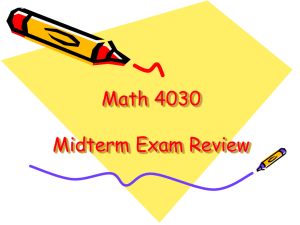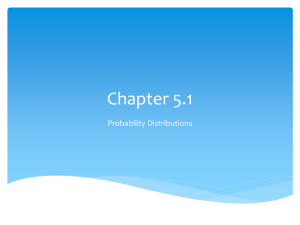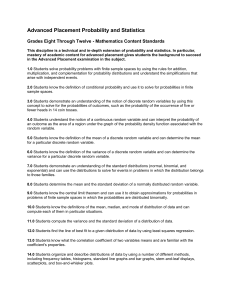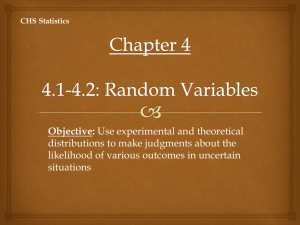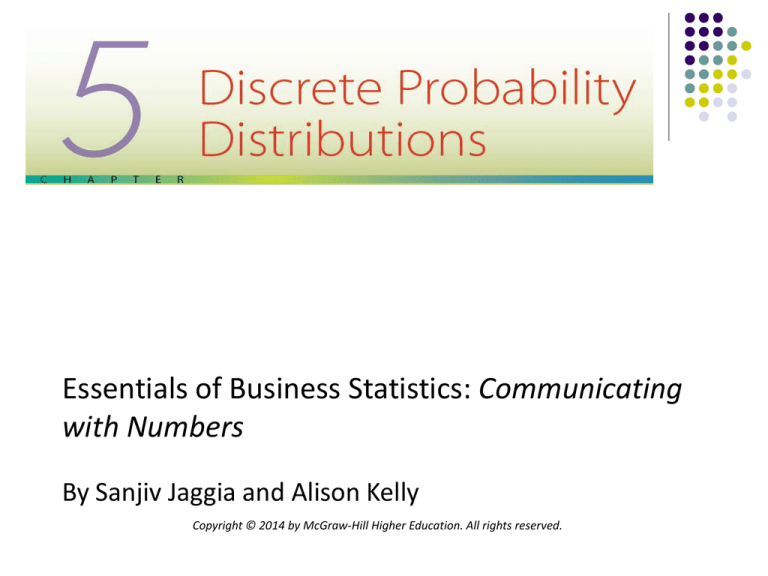
Essentials of Business Statistics: Communicating
with Numbers
By Sanjiv Jaggia and Alison Kelly
Copyright © 2014 by McGraw-Hill Higher Education. All rights reserved.
Chapter 5 Learning Objectives
LO 5.1
LO 5.2
LO 5.3
LO 5.4
LO 5.5
LO 5.6
Distinguish between discrete and continuous
random variables.
Describe the probability distribution of a discrete
random variable.
Calculate and interpret summary measures for a
discrete random variable.
Describe the binomial distribution and compute
relevant probabilities.
Describe the Poisson distribution and compute
relevant probabilities.
Describe the hypergeometric distribution and
compute relevant probabilities.
Discrete Probability Distributions
5-2
5.1 Random Variables and Discrete
Probability Distributions
LO 5.1 Distinguish between discrete and continuous random
variables.
Random variable
A function that assigns numerical values to the
outcomes of an experiment.
Denoted by uppercase letters (e.g., X ).
Values of the random variable are denoted by
corresponding lowercase letters.
Corresponding values of the random variable:
x1, x2, x3, . . .
Discrete Probability Distributions
5-3
LO 5.1
5.1 Random Variables and Discrete
Probability Distributions
Random variables may be classified as:
Discrete
The random variable assumes a countable number
of distinct values.
Continuous
The random variable is characterized by (infinitely)
uncountable values within any interval.
Discrete Probability Distributions
5-4
5.1 Random Variables and Discrete
Probability Distributions
LO 5.2 Describe the probability distribution of a discrete
random variable.
Every random variable is associated with a probability
distribution that describes the variable completely.
A probability mass function is used to describe discrete
random variables.
A probability density function is used to describe
continuous random variables.
A cumulative distribution function may be used to
describe both discrete and continuous random variables.
Discrete Probability Distributions
5-5
LO 5.2
5.1 Random Variables and Discrete
Probability Distributions
The probability mass function of a discrete
random variable X is a list of the values of X with
the associated probabilities, that is, the list of all
possible pairs
x, P X x
The cumulative distribution function of X is
defined as
P X x
Discrete Probability Distributions
5-6
LO 5.2
5.1 Random Variables and Discrete
Probability Distributions
Two key properties of discrete probability
distributions:
The probability of each value x is a value between
0 and 1, or equivalently
0 P X x 1
The sum of the probabilities equals 1. In other words,
PX x 1
i
where the sum extends over all values x of X.
Discrete Probability Distributions
5-7
LO 5.2
5.1 Random Variables and Discrete
Probability Distributions
A discrete probability distribution may be viewed as
a table, algebraically, or graphically.
For example, consider the experiment of rolling a sixsided die. A tabular presentation is:
Each outcome has an associated probability of 1/6.
Thus, the pairs of values and their probabilities form
the probability mass function for X.
Discrete Probability Distributions
5-8
LO 5.2
Another tabular view of a probability distribution is
based on the cumulative probability distribution.
5.1 Random Variables and Discrete
Probability Distributions
For example, consider the experiment of rolling a sixsided die. The cumulative probability distribution is
The cumulative probability distribution gives the
probability of X being less than or equal to x.
For example, P X 4 4 6
Discrete Probability Distributions
5-9
LO 5.2
5.1 Random Variables and Discrete
Probability Distributions
A probability distribution may be expressed
algebraically.
For example, for the six-sided die experiment, the
probability distribution of the random variable X is:
1 6 if x 1,2,3,4,5,6
P X x
0 otherwise
Using this formula we can find
P X 5 1 6
P X 7 0
Discrete Probability Distributions
5-10
LO 5.2
5.1 Random Variables and Discrete
Probability Distributions
A probability distribution may be expressed graphically.
The values x of X are placed on the horizontal axis and the
associated probabilities on the vertical axis.
A line is drawn such that its height is associated with the
probability of x.
For example, here is the
graph representing the
six-sided die experiment:
This is a uniform distribution
since the bar heights are all
the same.
Discrete Probability Distributions
5-11
5.2 Expected Value, Variance, and
Standard Deviation
LO 5.3 Calculate and interpret summary measures
for a discrete random variable.
Summary measures for a random variable include
the
Mean (Expected Value)
Variance
Standard Deviation
Discrete Probability Distributions
5-12
LO 5.3
5.2 Expected Value, Variance, and
Standard Deviation
Expected Value
E(X)
Population Mean
E(X) is the long-run average value of the random
variable over infinitely many independent repetitions
of an experiment.
For a discrete random variable X with values
x1, x2, x3, . . . that occur with probabilities
P(X = xi), the expected value of X is
E X xi P X xi
Discrete Probability Distributions
5-13
LO 5.3
5.2 Expected Value, Variance, and
Standard Deviation
Variance and Standard Deviation
For a discrete random variable X with values
x1, x2, x3, . . . that occur with probabilities
P(X = x ),
i
Var X xi P X xi
2
2
xi2P X xi 2
The standard deviation is the square root of the
variance.
SD X 2
Discrete Probability Distributions
5-14
5.3 The Binomial Probability Distribution
LO 5.4 Describe the binomial distribution and compute
relevant probabilities.
A binomial random variable is defined as the number
of successes in n trials of a Bernoulli process.
A Bernoulli process consists of a series of n
independent and identical trials of an experiment
such that on each trial:
There are only two possible outcomes:
p = probability of a success
1p = q = probability of a failure
Each time the trial is repeated, the probabilities of
success and failure remain the same.
Discrete Probability Distributions
5-15
LO 5.4
5.3 The Binomial Probability
Distribution
A binomial random variable X is defined as the
number of successes achieved in the n trials of a
Bernoulli process.
A binomial probability distribution shows the
probabilities associated with the possible values of
the binomial random variable (that is, 0, 1, . . . , n).
For a binomial
random variable X ,
the probability of x
successes in n
Bernoulli trials is …
P X x nx p x q n x
n!
p xq nx
x ! n x !
for x 0,1,2, , n. By definition, 0! 1.
Discrete Probability Distributions
5-16
LO 5.4
5.3 The Binomial Probability
Distribution
For a binomial distribution:
The expected value E X np
(E(X)) is:
The variance (Var(X)) is: Var X σ 2 np1 p
The standard deviation
SD X σ np1 p
(SD(X)) is:
Discrete Probability Distributions
5-17
5.4 The Poisson Probability Distribution
LO 5.5 Describe the Poisson distribution and compute relevant
probabilities.
A binomial random variable counts the number of
successes in a fixed number of Bernoulli trials.
In contrast, a Poisson random variable counts
successes over a given interval of time or space.
Examples of a Poisson random variable include
With respect to time—the number of cars that cross the
Brooklyn Bridge between 9:00 am and 10:00 am on a
Monday morning.
With respect to space—the number of defects in a
50-yard roll of fabric.
Discrete Probability Distributions
5-18
LO 5.5
5.4 The Poisson Probability
Distribution
A random experiment satisfies a Poisson
process if:
The number of successes within a specified time or
space interval equals any integer between zero and
infinity.
The numbers of successes counted in
nonoverlapping intervals are independent.
The probability that success occurs in any interval is
the same for all intervals of equal size and is
proportional to the size of the interval.
Discrete Probability Distributions
5-19
LO 5.5
5.4 The Poisson Probability
Distribution
For a Poisson random variable X, the
probability of x successes over a given interval
of time or space is
e x
P X x
x!
for x 0,1,2 ,
where is the mean number of successes and
e 2.718 is the base of the natural logarithm.
Discrete Probability Distributions
5-20
LO 5.5
5.4 The Poisson Probability
Distribution
For a Poisson distribution:
The expected value (E(X)) is: E X
The variance (Var(X)) is: Var X 2
The standard deviation SD X
(SD(X)) is:
Discrete Probability Distributions
5-21
5.5 The Hypergeometric Probability
Distribution
LO 5.6 Describe the hypergeometric distribution and compute
relevant probabilities.
A binomial random variable X is defined as the number of
successes in the n trials of a Bernoulli process, and
according to a Bernoulli process, those trials are
Independent and
The probability of success does not change from trial to trial.
In contrast, the hypergeometric probability distribution is
appropriate in applications where we cannot assume the
trials are independent.
Discrete Probability Distributions
5-22
LO 5.6
5.5 The Hypergeometric Probability
Distribution
Use the hypergeometric distribution when sampling
without replacement from a population whose size N
is not significantly larger than the sample size n.
For a hypergeometric random variable X, the probability of x
successes in a random selection of n items is
S N S
x n x
P X x
Nn
for x 0,1,2, , n if n S or x 0,1,2, , S if n S,
where N denotes the number of items in the population of
which S are successes.
Discrete Probability Distributions
5-23
LO 5.6
5.5 The Hypergeometric Probability
Distribution
For a hypergeometric distribution:
The expected value (E(X)) is:
The variance (Var(X))
is:
The standard deviation
(SD(X)) is:
S
E X n
N
S S N n
Var X 2 n 1
N N N 1
S S N n
SD X n 1
N N N 1
Discrete Probability Distributions
5-24


